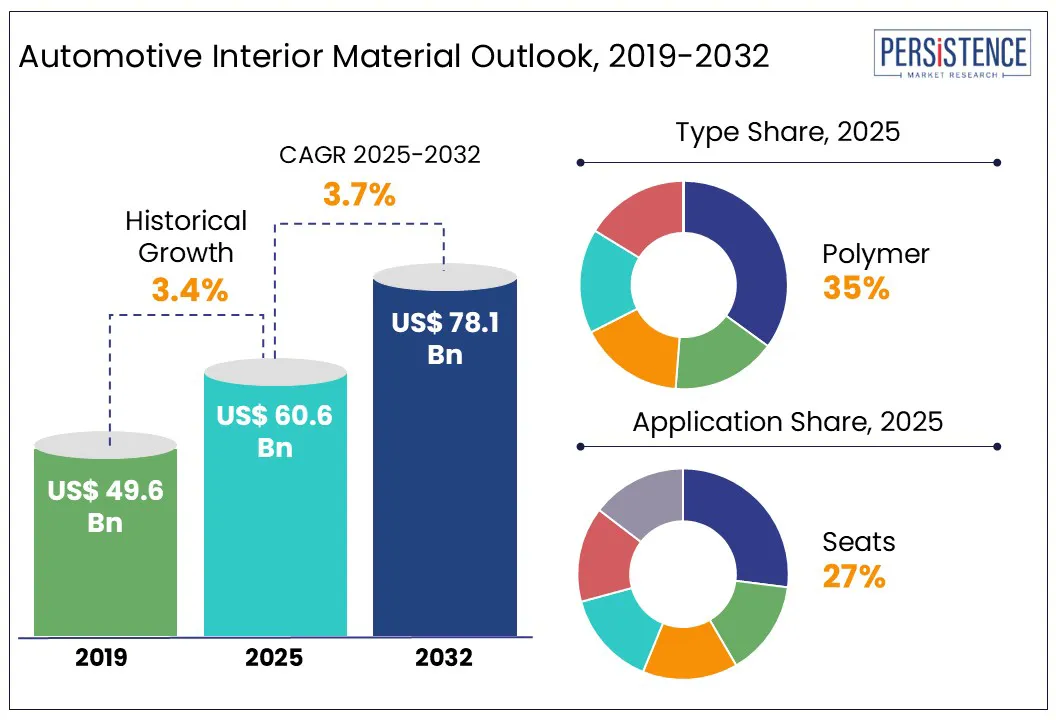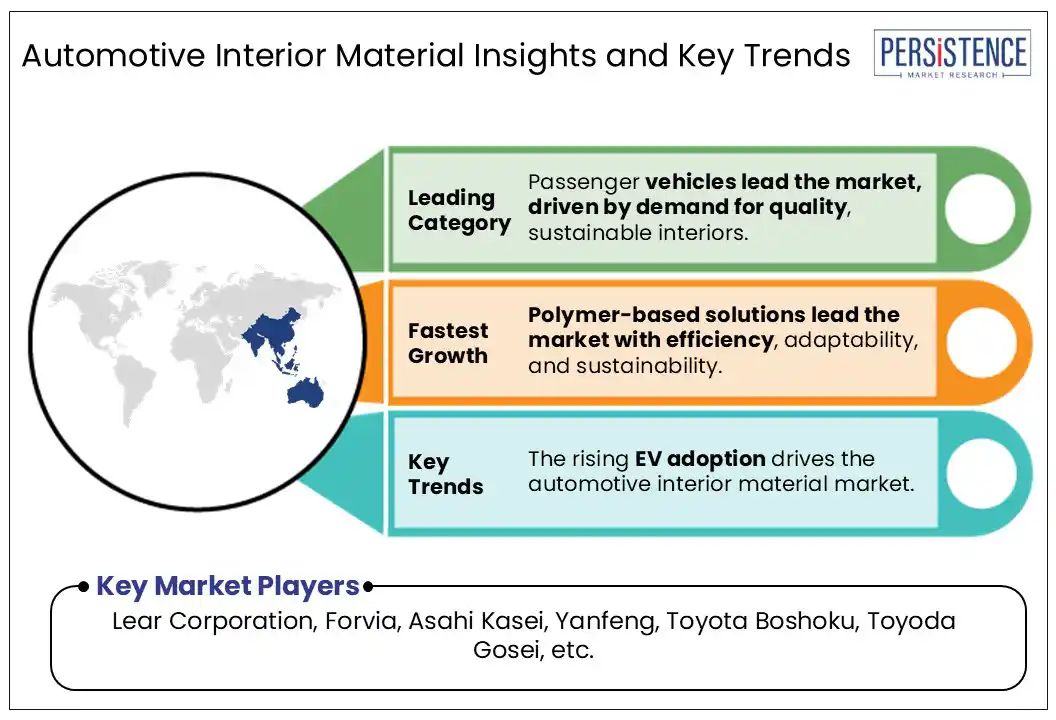ID: PMRREP3669| 199 Pages | 23 Jun 2025 | Format: PDF, Excel, PPT* | Automotive & Transportation

The global automotive interior material market size is projected to rise from US$ 60.6 Bn in 2025 to US$ 78.1 Bn by 2032, growing at a CAGR of 3.7% in the forecast period from 2025 to 2032.
The automotive interior material market is shifting toward smart, sustainable, and lightweight interior materials, driven by the rising EV adoption, consumer demand for premium in-cabin experiences, and stringent environmental regulations. Manufacturers are focusing on recyclable polymers and tech-integrated comfort features.

Key Industry Highlights:
|
Global Market Attribute |
Key Insights |
|
Automotive Interior Material Market Size (2025E) |
US$ 60.6 Bn |
|
Projected Market Value (2032F) |
US$ 78.1 Bn |
|
Global Market Growth Rate (CAGR 2025 to 2032) |
3.7% |
|
Historical Market Growth Rate (CAGR 2019 to 2024) |
3.4% |
Consumers prefer comfort, luxury, and sophisticated interior experiences when purchasing vehicles, driving automakers to invest heavily in premium materials and advanced cabin technologies. Demand now spreads beyond luxury segments, with buyers in all categories seeking facilities like ergonomic seating, ambient lighting, and personalized comfort that elevate the driving experience.
Responding to the evolving needs, key players have intensified their innovation efforts. For instance, Lear Corporation announced in February 2025 a groundbreaking integration with General Motors to launch the ComfortMax Seat, first-of-its-kind solution integrates thermal comfort technologies into trim covers, delivering superior thermal management that achieves up to 40% faster time-to-sensation for both heating and ventilation while reducing part count by 50%.
Government initiatives are also actively support this trend, demonstrated by India's mandate requiring air-conditioned cabins for all new trucks manufactured from October 1, 2025. This regulation acknowledges that enhanced cabin comfort directly impacts driver safety, productivity, and well-being, particularly in extreme weather conditions.
Fluctuating raw material prices, especially steel, aluminum, and petrochemical-based polymers, disrupt cost predictability, strain profit margins, and complicate pricing negotiations with OEMs. Driven by geopolitical tensions and shifting trade policies, these changes increase procurement challenges for key materials like high-grade plastics and recycled textiles.
India’s Price Stabilisation Fund mechanism actively intervenes to ease extreme price swings in critical commodities, shielding manufacturers from abrupt cost escalations. The fund’s strategic procurement and distribution protocols stabilize markets for metals and polymers, ensuring consistent raw material availability for auto component production.
Such volatility creates challenges for manufacturers in maintaining pricing consistency and profit margins, especially when fulfilling long-term OEM contracts.
The adoption of EVs is shifting the automotive interiors materials market, creating enormous opportunities for smart and sustainable cabin solutions. As EV adoption rushes globally, the automotive manufacturers are redesigning the cabin to enhance the user experience with the help of advanced technologies. Consumers also expect vehicles to offer smart technologies, equipped with voice assistants, immersive displays, and seamless connectivity to personal devices.
Government policies worldwide support EV expansion through incentives and stricter regulations, further fueling demand for innovative interior materials and technologies. For example, China’s leadership in vehicle architecture transformation is setting global trends by integrating smart cabin technologies and accelerating EV volumes.
Industry players such as Yanfeng are partnering with Loomia for development of next generation smart cabins. By combining Yanfeng’s automotive interior expertise with Loomia’s e-textile circuit technology, the partnership focuses on creating interiors that merge comfort, safety, and interactivity. Such advancements demonstrate how smart materials and integrated electronics are becoming essential in EV design.
Polymers leads the market due to their lightweight properties and adaptability to versatile applications. Manufacturers emphasize the fuel efficiency and cost-effectiveness by choosing polymers for various applications such as airbags, seat belts, dashboards, and trims, especially in mid-size and electric vehicles.
Reinforcing this, leading manufacturers are investing in the polymer products for the vehicle interiors. For instance, Yanfeng introduced the Reco Seat in March 2024, a sustainable seat structure that incorporates polyurethane (PU) trim and thermoplastic foam, both polymer-based materials. This product delivers over 20% carbon emission reduction, showcasing the pivotal role of polymers in eco-innovation and functional integration for next-generation vehicle interiors.
Polymer is important in the design of vehicle interior due to its capability to be molded into complex shapes, with compatibility to advanced and sustainable technologies. Continuous advancements in recycled polymer composites are significantly enhancing both their sustainability and performance, thus positioning the segment as a leader in the market.
Based on application, seats are dominant segments for their significant role in delivering comfort, and safety. The growth of automotive industry, with increasing consumer demand for luxury, convenience, and customizable comfort features, is anticipated to drive significant expansion in the seat segment.
As vehicle interiors increasingly serve the important functions, particularly within the sectors of electric and luxury vehicles, OEMs are making substantial investments in the development of seating solutions that are not only convenient and stylish but also seamlessly integrated with smart technologies.
The manufacturers are investing in product developments, especially in the seats. For instance, in Jan 2024, Yanfeng unveiled the next generation of its Hover seat, featuring Seat Sensing Posture ID technology to reduce fatigue and enhance overall comfort and driving experience actively. The development represents a significant shift toward smart, high-performance seating systems, thereby establishing the seat as a key component of innovation and reinforcing its position as the leading application segment.
Passenger vehicles leads the market driving demand for automotive interior materials globally. According to Society of Indian Automotive Manufacturers, in FY 2024-25, India recorded its highest-ever passenger vehicle sales of 4.3 million units, reflecting a 2% growth over the previous year, highlighting the segment’s growing interest by consumers. Market players are also increasingly focusing on good quality interior materials, such as polymers, fabrics, and composites, to attract the consumers following sustainability regulations.
The global as well as regional manufacturers are investing especially in passenger vehicle interiors. For instance, in August 2023, Toyota Boshoku Corporation established Toyota Boshoku Western Kentucky, LLC., a new facility in the U.S. dedicated to producing interior parts for passenger vehicles. The company aims to meet rising demand while enhancing competitiveness in the North American market.
This features proves the dominance of passenger vehicles in the market, driving through the material innovation and the volume growth.

North America, led primarily by the U.S., holds a significant share in the global automotive interior materials market, driven by strong demand for EVs and passenger vehicles. The region’s market growth is supported by increasing investments in research and development focused on smart and eco-friendly interiors.
The market here is strengthened by growing infrastructure development, modernization of manufacturing facilities, and focus on compliance with environmental standards. The global leading manufacturers are investing in the region to benefit from the market growth.
For instance, in October 2023, Asahi Kasei planned to invest in US-based startup NFW, a producer of non-petroleum-based leather alternative for car interiors. As part of Asahi Kasei's medium-term growth strategy, this partnership enabled another major step to support global automotive OEMs in reducing the environmental burden of automobiles.
The U.S. government actively supports the initiatives such as reductions in CO? emissions through regulations like the Corporate Average Fuel Economy, which incentivize the use of lighter, durable, and efficient interior materials. This regulatory push strengthens opportunities for manufacturers to invest in the innovative designs supporting the environmental sustainability.
Europe plays an important role in the automotive interior material market driven by its strict regulatory environment and growing focus on sustainability with design innovation. The rising shift in the adoption of EVs from the consumers leads the manufacturers towards development of smart interiors solutions. The market further benefits due to the high demand for premium and eco-friendly interior solutions that prioritize sustainability.
European governments support green mobility, pushing manufacturers and suppliers to develop interiors using recyclable and low-emission materials. The region’s regulatory standards such as ELV Directive 2000/53/EC leads the manufacturers in integrating eco-friendly and lightweight materials.
Supporting this shift, manufacturers are investing in recyclable materials to meet the regulatory standards. For instance, Yanfeng and Trinseo announced a collaboration in May 2024 to accelerate the development of circular interior materials using mechanical recycling and dissolution technologies, addressing OEMs' 2030 ELV requirements.
Asia Pacific is a leader as the growth is driven by the rise in vehicle production, and disposable incomes and rise in consumer demand for affordable with high features vehicles. Governments across emerging economies, such as China, India, and Japan, promote domestic manufacturing of EVs, due to their sustainability, through policy incentives, localization mandates, and environmental regulations. This accelerates the demand for cost-effective and scalable interior solutions.
Reinforcing regional momentum, manufacturers are increasing production capacity. For instance, FORVIA and BYD opened a new seat assembly plant in Rayong, Thailand in July 2024, under their joint venture. This facility supports BYD’s growing production and introduces FORVIA’s smart, modular seating systems tailored for regional EV models.
The region primarily uses the polymers due to their versatility, lightweight properties, and suitability for mid-size and compact vehicles. The use of polymers makes it easy for the bulk manufacturing and the sales of vehicles in Asia.
The global automotive interior materials market is highly competitive, driven by strategic partnerships and acquisitions, product innovation, and sustainability-driven initiatives to meet evolving consumer demands and regulatory requirements. The automotive interior materials market is highly competitive and characterized by the presence of several global leaders investing heavily in innovation, sustainability, and advanced technologies to meet evolving consumer demands and regulatory requirements.
The leading market players are continually investing in R&D to integrate smart features, advanced composites, and recycled materials in most of the vehicle parts. The innovation also includes balancing the cost, performance, and environmental compliance to differentiate their offerings in a rapidly evolving market.
The automotive interior material market is set to reach US$ 78.1 Bn by 2032.
India is estimated to witness a CAGR of 4.9% in the forecast period.
Lear Corporation is considered the leading player in the automotive interior material market.
The Automotive Interior Material Market is poised to grow at a 3.7% CAGR by 2032.
Some major players listed in the automotive interior material market include Lear Corporation, Forvia Hella, Toyota Boshoku, Asahi Kasei, and Toyoda Gosei.
|
Attributes |
Details |
|
Forecast Period |
2025 to 2032 |
|
Historical Data Available for |
2019 to 2024 |
|
Market Analysis |
US$ Million for Value |
|
Key Regions Covered |
|
|
Key Market Segments Covered |
|
|
Key Companies Profiled in the Report |
|
|
Report Coverage |
|
|
Customization & Pricing |
Available upon request |
By Type
By Application
By Vehicle Type
By Region
Delivery Timelines
For more information on this report and its delivery timelines please get in touch with our sales team.
About Author